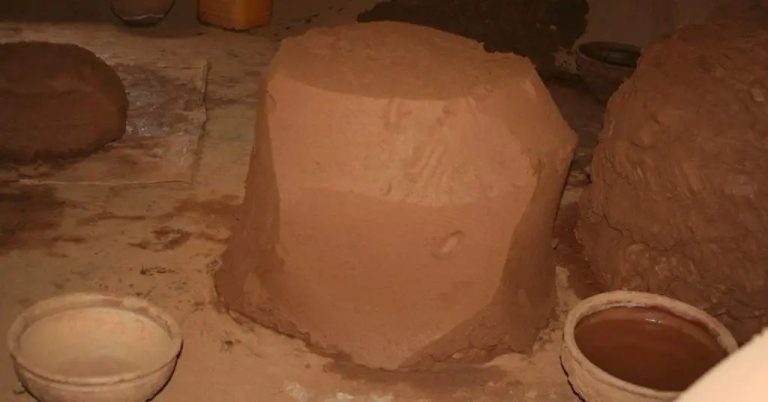What Is Natural Earth Clay?
What is Clay?
Clay is a naturally occurring material composed primarily of fine-grained minerals like silica and alumina. It is formed over long periods of time by the gradual chemical weathering of rocks, usually igneous rocks like granite. The weathering process breaks down the original rock into smaller and smaller particles that are then transported by water, wind or ice to accumulate in deposits. Over geologic time, these particles consolidate into sedimentary rock layers composed predominantly of clay-sized particles less than 0.002 mm in diameter.
The primary constituents of clay are phyllosilicates, or sheet silicates, which have a layered atomic structure that gives clay its characteristic plate-like shape and small grain size. The most common phyllosilicate clay minerals are kaolinite, montmorillonite-smectite, illite and chlorite. Clay deposits are typically found in low-energy depositional environments like river deltas, floodplains and marine basins where fine sediment can settle out of standing water.
Due to its abundance, small particle size and plasticity when wet, clay is an incredibly versatile material that can be found in a diverse range of colors and textures across the planet.
Clay Formation
Clay is formed from the chemical weathering of feldspar-rich rocks like granite, gneiss and shale. This process breaks down the feldspar minerals within the rocks into kaolinite, which is the primary mineral within clay. Kaolinite has a sheet-like structure, which gives clay its plasticity and ability to harden when dried or fired.
The chemical weathering process usually happens over long periods of time in wet, tropical environments where abundant rainfall helps leach the feldspar minerals out of rock. As rainfall percolates through fractures in the rocks, it reacts with carbon dioxide in the air and weak carbonic acid forms. This slightly acidic water then slowly dissolves the feldspar minerals, releasing silicon, aluminum and potassium ions which then combine with water molecules to form kaolinite.
In addition to chemical weathering, physical weathering processes like cycles of freezing and thawing can also break down rocks and liberate kaolinite. The kaolinite particles are very small, often less than 2 micrometers in size. These tiny plate-like particles give clay its soft, smooth texture. The kaolinite particles are also strongly attracted to water molecules due to hydrogen bonding, which allows clay to readily absorb water.
Over long timescales, erosive forces like rivers and glaciers transport the weathered rock containing kaolinite downstream as sediment. When the sediment is deposited in lakes, oceans or other calm environments, the very fine clay particles settle out, accumulating as clay deposits. The purity and properties of the clay depend on the source rocks and the depositional environment.
Properties of Clay
Clay has many unique properties that make it useful for a wide range of applications. Some key properties of clay include:
Plasticity
Clay is highly plastic due to its molecular structure. This means it can be molded into different shapes and will hold its form. The plasticity of clay enables it to be worked into sculptures, pots, tiles, and more.
Absorbency
Clay is porous and can absorb significant amounts of water. However, it does not dissolve in water. This absorbent quality allows clay to be mixed into a slip or slurry form for glazing.
Durability
When clay is fired at high temperatures through a process called vitrification, it becomes very strong and durable. Vitrified clay can last thousands of years without deterioration.
Color
Clay can be found in a range of natural colors based on mineral content. Common colors include red, brown, grey, and white. When fired, clay can also take on new colors from any glazes or pigments added.
Types of Clay
There are several major types of natural clay that have unique properties and uses:
Kaolin – Also known as China clay, this white clay is ideal for making porcelain. It fires to a pure white color and is highly refractory. Kaolin clay is very pure, with few impurities.
Bentonite – This clay has high plasticity and swells significantly in water, making it ideal for bonding and sealing. Bentonite is used for mud drilling and making liners for ponds and reservoirs.
Ball clay – A very plastic secondary clay with high fired strength and minimal impurities. Ball clay is essential for making high quality ceramics. It fires to a light cream color.
Fire clay – Refractory clays that can withstand very high temperatures without deforming. Fire clays are used to line kilns and furnaces. They have low impurities that cause distortion.
There are many other specialty clays as well, including stoneware clay, earthenware clay, and porcelain. Each has unique mineralogical and chemical compositions suited to particular applications.
Uses of Clay
Clay has been used by humans for thousands of years due to its abundance and versatility. Some of the main uses of clay include:
Pottery and Ceramics: Clay is the primary material used to make pottery and ceramic objects. When clay is mixed with water, it can be molded into any shape and baked at high temperatures to harden and create durable pottery. Clay comes in various colors and properties, allowing artisans to create beautiful bowls, plates, vases, tiles, and sculptures.
Construction: Clay is an important material in construction. Bricks and building blocks made from clay have been used since ancient times to build houses and structures. Clay is also used to make mortar and plaster for walls. The earth floors in homes have historically been made using rammed earth techniques with clay.
Cosmetics: Facial and skin clays such as kaolin and bentonite are used in various cosmetic formulations. Clay masks help cleanse and nourish the skin. The absorbent nature of clay allows it to draw out impurities from skin pores.
Medicine: Medicinal clays have been used since prehistoric times to treat wounds, pains, and other ailments. Specific types of clays are ingested or applied topically as natural remedies for conditions like diarrhea, dysentery, and even poisoning.
Harvesting Clay
Clay is harvested from deposits found across the world, typically in certain regions and geologic formations where natural clay has accumulated over long periods of time. The most significant sources of clay are surface mines, which access seams of clay close to the surface of the earth.
Surface clay is extracted through open-pit mining, also known as open-cast mining, using heavy equipment to remove and collect the clay. Backhoes, power shovels, and strip mining machines scrape away layers of earth to expose the seams of clay underneath. Front-end loaders scoop the clay into trucks for removal from the mining area. The mining process creates open pits in the earth which are then backfilled as mining is completed in each area.
For clay deposits that are too deep underground for surface mining, underground mining methods are used. Tunnels are dug down to access the clay seam, which is extracted through the tunnel. Continuous mining machines break up the clay which is then transported by shuttle cars and conveyors to the surface. The room and pillar method is also used, creating a grid of tunnels supported by pillars of unmined clay.
Dredging may also be used to access clay underwater, such as in rivers, lakes, and oceans where loose clay has settled. Dredgers equipped with scoops and suction pumps remove the clay which is pumped as slurry to the surface for processing.
Proper environmental protections and reclamation efforts are important when mining clay to minimize habitat disruption. Careful planning and operating practices help reduce the impacts of clay mining on the surrounding environment.
Processing Clay
After clay is harvested, it undergoes several processing steps before it is ready to be used. This processing helps improve the clay’s workability, durability, and aesthetic qualities.
The first step is cleaning and blending. Clay straight from the ground often contains impurities like rocks, roots, and organic material. These need to be removed through a process of crushing, soaking, and sieving the clay mixture. Multiple types of clay may also be blended together at this stage to achieve desired properties.
Next is kneading or wedging, where the clay is worked to remove air bubbles and create an even consistency. This helps prevent cracking and weak spots when shaping the clay.
Once the clay is cleaned and wedged, it can be shaped as desired through techniques like throwing, handbuilding, molding, or extruding. The shaped clay artwork is then left to dry slowly and evenly to prevent cracking.
After the clay has dried, it undergoes a bisque firing at a high temperature around 1100–1200°F. This hardens the clay so it can be handled without deforming. The bisque firing prepares the clay for the final glazing and firing steps.
Glazes may be applied before a final high temperature firing around 2200°F. The glaze melts and fuses to the clay body during this firing, making the surface impervious to water and giving it a glassy finish.
Firing clay requires carefully controlled kilns that can reach very high temperatures. The final result is a strong, finished ceramic object.
Clay Artistry
Clay has a long history of being used for art and sculpture. Some of the earliest known pottery artifacts date back over 20,000 years. Clays plasticity lends itself well to sculpting and throwing on the pottery wheel. When fired at high temperatures, clay becomes hard and durable.
Pottery was independently invented in many cultures across the world. In Asia, Native American cultures, and Africa, pottery was often decorated with geometric shapes or nature scenes painted on with clay slips. Pottery became an art form across many ancient civilizations. The ancient Greeks are particularly known for their figure pots decorated with black figure or red figure painting.
Clay is also a popular medium for sculpture. Sculptures can be made by hand building with slabs, coils, or other techniques. Or by casting liquid slip into molds. Like pottery, sculptures may be painted and fired for durability. Historic sculptures were often made of terracotta clay. And clay continues to be used by sculptors today.
With its versatility and long history, clay remains one of the most popular mediums for pottery, sculpture, and art across the world. Craftspeople and artisans continue to find new ways to shape, decorate, and fire clay into beautiful works.
Clay in Construction
Clay has been an integral material in construction and architecture for thousands of years. Some of the most common uses of clay in building and construction include:
Bricks
Clay bricks are one of the oldest man-made building materials, with evidence of their use dating back over 5,000 years ago. Bricks are made by shaping moist clay into blocks, which are then fired in a kiln to harden them. Clay bricks are durable, fireproof, and effective insulators, making them ideal for constructing walls, floors, foundations, and other structural elements. Modern clay bricks are mass-produced and are a ubiquitous construction material around the world.
Flooring
Clay tiles and bricks have been used to pave floors for millennia. Clay is molded and fired into hard, durable tiles in a variety of shapes, colors, and textures for flooring. Clay floor tiles are water-resistant, easy to clean, and stand up well to heavy foot traffic. Terracotta and ceramic tiles are common forms of clay flooring.
Pipes and Conduits
Clay pipe and drainage systems were some of the earliest plumbing technologies. Clay is an ideal material for manufacturing pipes because of its durability, longevity, and impermeability. Clay pipes provide reliable drainage and sewage conveyance, and also serve as conduits for protecting electrical and telecommunication cables underground. Clay pipes and drainage systems continue to be widely used in modern infrastructure.
Roofing
Fired clay roof tiles have been used since ancient times as an alternative to less durable thatch and wooden roofs. Overlapping clay shingles or tiles provide excellent waterproofing while also being fireproof, insect-resistant, and durable. Clay roof tiles are still popular in many parts of the world thanks to their aesthetic appeal and reliability.
Stucco
Stucco is a type of plaster composed of sand, lime, clay, and water. It has been applied to walls and used as a decorative coating for interiors and exteriors for thousands of years. The clay provides plasticity and strength to the plaster. Stucco protects against weather while also beautifying structures.
Natural vs. Synthetic Clay
Clay is a naturally occurring material composed mainly of fine-grained minerals like kaolinite. It is pliable in its moist state and hardens when dried or fired. Natural clays form over long periods of time due to weathering and erosion of rocks. They can be harvested directly from the earth and used for pottery, sculpture, construction, and other applications.
Synthetic clays, on the other hand, are produced artificially in factories to mimic the properties of natural clays. The main types of synthetic clays are earthenware clays, stoneware clays, and porcelain clays. They are made by combining minerals like kaolin, feldspar, silica, and ball clay. The composition can be controlled to optimize properties like plasticity, strength, hardness, and firing temperature.
The key differences between natural and synthetic clays are origin, composition, properties, and cost. Natural clays have impurities while synthetic clays are tailored to specifications. Synthetic clays are more expensive but offer consistency and control. Applications that need high performance and consistency, like sanitaryware and technical ceramics, tend to utilize synthetic clays. Traditional pottery and artisan wares more commonly use natural clays.




